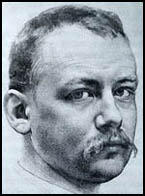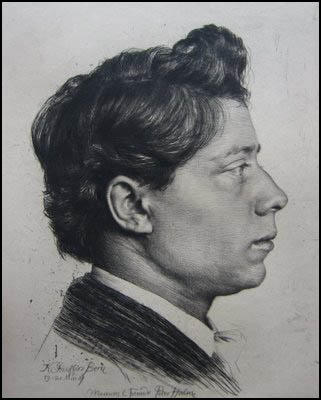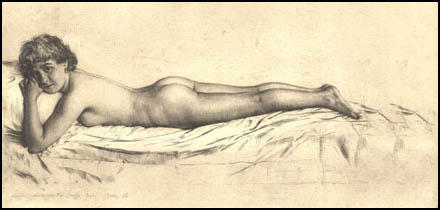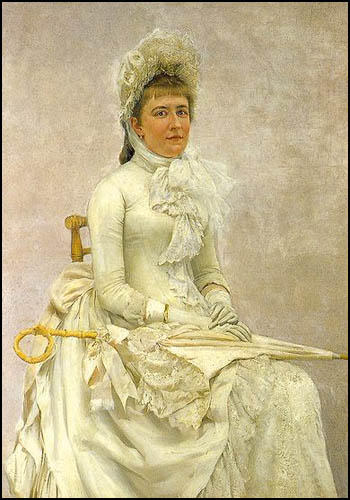Karl Stauffer-Bern

In 1880, he moved to Berlin, where he began to build a reputation as a portrait painter. He also found work as a teacher at Berlin School for Women Artists. One of his students was Käthe Kollwitz.
The author of Käthe Kollwitz (1976) has argued: "Karl Stauffer-Bern, was a jack-of-all-arts; at twenty-seven, he had already displayed talents as a poet, painter, sculptor, and etcher, and was a perceptive teacher as well. Stauffer-Bern had little respect for the sort of work favoured by the Academy in 1885 - enormous, academic canvases of battlefields."
Stauffer-Bern introduced Kollwitz to the work of Max Klinger. The art critic, Martha Kearns, has pointed out: "She (Käthe) had never heard of Max Klinger, Prussia's most skilled artist of the then-popular naturalism, a school of thought which deemed people to be predetermined victims in a bitter struggle for survival. As an art form, naturalism emphasized photolike images of actual persons, scenes, and conditions, often in the most minute, even microscopic detail. Unlike artists working in other styles, naturalist artists featured women as subjects as frequently as men."
During this time he wrote to a friend that "among Berlin's one-and-a-half-million inhabitants, there isn't anyone of my own age who I feel is a kindred spirit in the world of art, so here I am, with no one to turn to for companionship, its the very devil." He had little respect for people who liked his work and called his admirers "blind".
In 1884 the German etcher, Peter Halm introduced Stauffer-Bern to the technique of engraving. His biographer has argued: "Stauffer-Bern continued his study of engraving on his own, and quickly became one of the most talented print-makers of his time, creating an outstanding series of portraits of his family, his friends, and of leading Swiss and German personalities."

His biographer, Matthias Frehner, has pointed out: "As a painter, engraver and graphic artist, he created powerful and striking character analyses.... The man from Bern was a manic creator who was not satisfied with merely painting. Self-taught, he created etchings of subtle quality. Stauffer-Bern switched between one activity and another with boundless enthusiasm and in the process accomplished great artistic achievements. In Berlin during the Wilhelminian period, his insistent naturalism corresponded to the taste of a wealthy stratum of society who enjoyed having him paint their portraits."
Stauffer-Bern returned to Switzerland where Friedrich Welti and his wife Lydia Welti-Escher became his most important patrons. Welti's father Emil Welti was an important figure in the government, and Lydia's father Alfred Escher, was the wealthy Gotthard railway magnate and co-founder of Credit Suisse.

In 1888, the Welti-Eschers agreed to finance a stay in Rome for Stauffer-Bern. The following year the Welti-Eschers moved to Florence. However, Friedrich Welti had to spend a lot of time on business in Switzerland. While he was away Stauffer-Bern and Lydia began a sexual relationship. When news of the relationship reached Welti, he used his government contacts to have Lydia committed to an asylum, and Stauffer-Bern was briefly sent to prison under trumped-up charges.

Stauffer-Bern was released from prison after several months, but soon afterwards he suffered a nervous breakdown and was committed to San Bonifazio clinic in Florence, one of the first hospitals for the mentally ill.
On his release he returned to Switzerland. Prevented from resuming his relationship with Lydia Welti-Escher, he attempted to shoot himself in the botanical gardens of Berne. The bullet closely missed his heart, and he survived. Stauffer-Bern now moved back to Florence where he attempted to revive his career as an artist.
Karl Stauffer-Bern died after taking an overdose of the sleeping drug chloral hydrate on 23rd January, 1891. He was buried in the Agli Allori Cemetery.
Lydia Welti-Escher, who had left her husband, committed suicide in December 1891, in Champel, Geneva.
Primary Sources
(1) Martha Kearns, Käthe Kollwitz (1976)
Karl Stauffer-Bern, was a jack-of-all-arts; at twenty-seven, he had already displayed talents as a poet, painter, sculptor, and etcher, and was a perceptive teacher as well. Stauffer-Bern had little respect for the sort of work favoured by the Academy in 1885 - enormous, academic canvases of battlefields.
